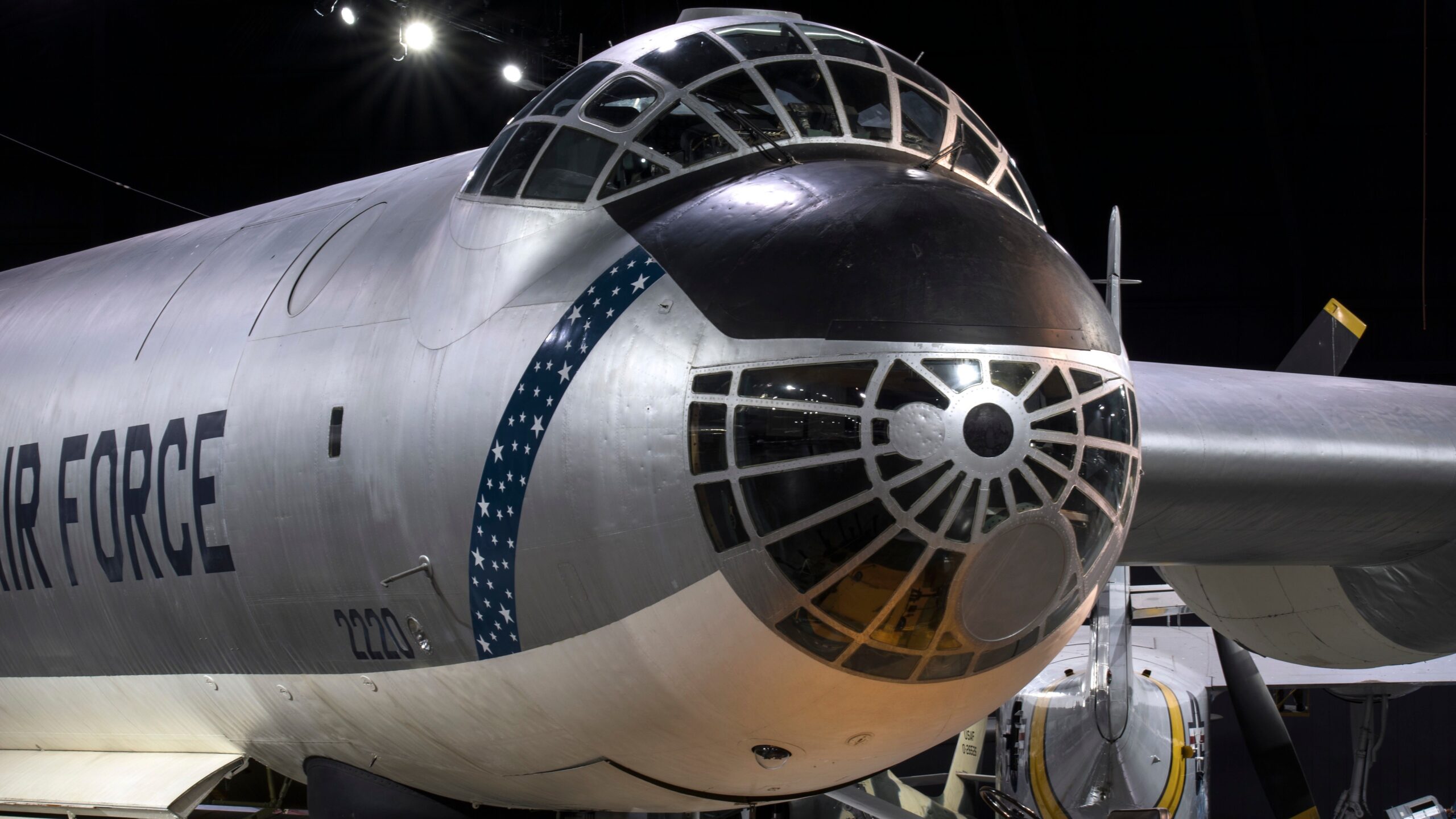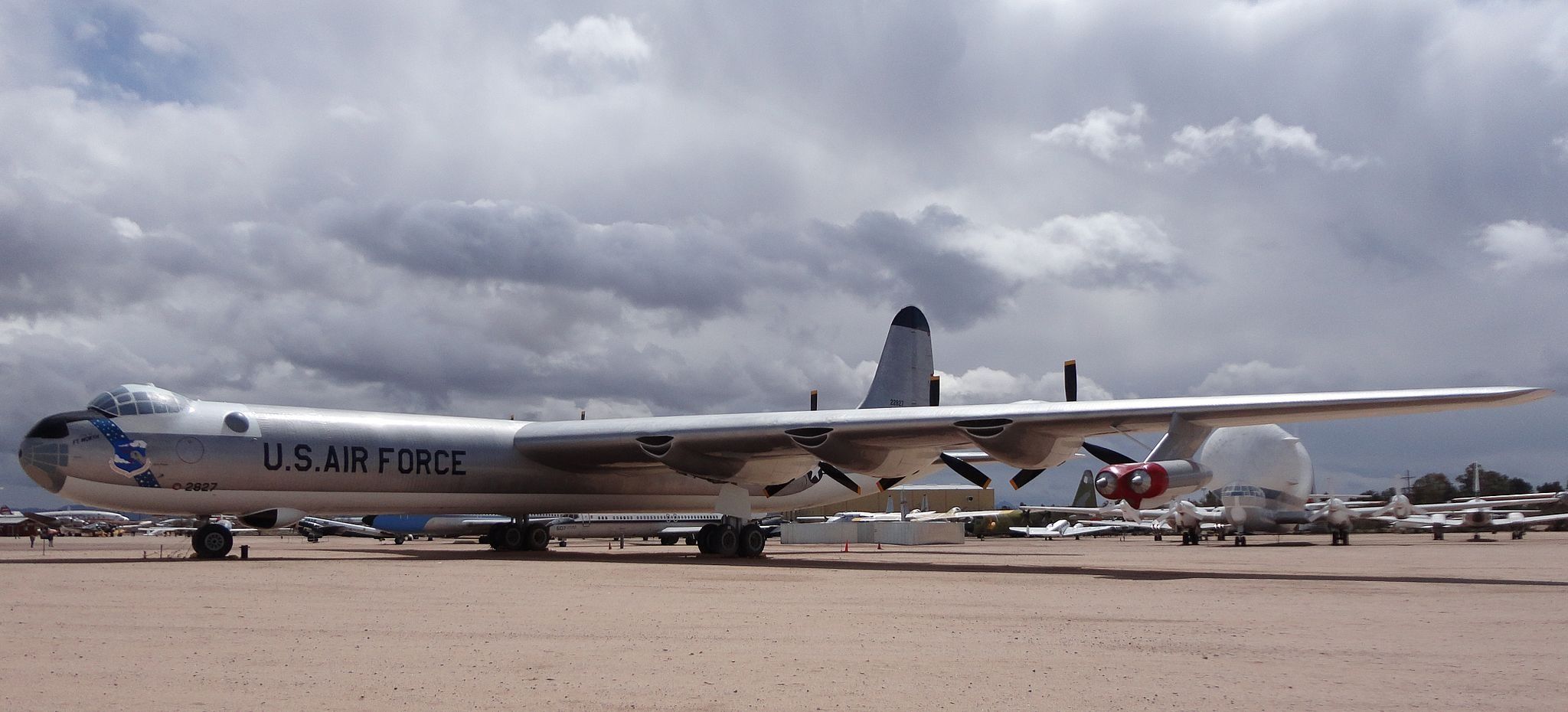Summary
- The Convair B-36 Peacemaker, designed as a strategic bomber, was a complex and awe-inspiring aircraft but was challenging to maintain.
- Despite missing World War II, the B-36 was crucial as a deterrent and surveillance platform in the Cold War.
- The Boeing B-52 Stratofortress eventually replaced the B-36.
The Convair B-36 Peacemaker strategic bomber was built to undertake strategic bombing over the oceans of North America. It development can be traced back to 1941, when there was a real risk of Britain falling to the German ‘Blitz,’ and the US couldn’t support its allies without a new airplane. It put out a request for a 450 mph top speed an a range of 12,000 miles, far exceeding the capabilities of aviation at the time.
The USAAC reduced its requirements to a range of 10,000 miles and a cruise speed of 240 – 300 mph. But the time it took to develop the B-36 meant it would miss the war entirely. It finally took to the skies in 1946, and was introduced with the USAF in 1959. However, the B-36 is no longer flying and only served for ten years and three months.
Ten-engined complex wonder with 230’ wings
The Convair B-36 Peacemaker was the largest mass-produced piston aircraft built, with 382 B-36s built plus a prototype XC-99 transport and two YB-60 all-jet engine variants. The combination of six Pratt & Whitney R-4360 Wasp Major four-row radial piston engines and four General Electric J47 turbojet engines for take-off thrust and dash speed assistance made for a complex aircraft.
Its complexity made the B-36 a wonder in the skies… and challenging to maintain. For instance, the B-36 required 40 maintenance hours for every hour of flight. Despite the rise of jet fighters and the many challenges of the aircraft, the B-36 would serve as a worthy deterrent sitting alert in cold northern airbases, as well as a reconnaissance platform.
The B-36 had at least a 15-member crew, starting with a pilot and a co-pilot. Additionally, a navigator working on dead reckoning aided by radar scans conducted by a radar officer and an observer who could use a sextant to navigate by stars would be working below. There also was a flight engineer, whose station is pictured above, to operate the engines and handle in-flight issues with the finicky engines. Additionally, the B-36 had gunners, photographic technicians, and a radio operator.
Missed World War II by six days, but ready for Cold War
The B-36 Peacemaker rolled out six days after the formal surrender of the Japanese Empire on the decks of the USS Missouri on September 2, 1945. But with the Soviet Union and the People’s Republic of China on a shared quest to impose communism around the world, a political iron curtain fell across Europe and Asia – the United States wanted a nuclear bomber and a reconnaissance platform with long range just-in-case. The B-36 Peacemaker fitted the bill, despite its complexity.
The B-36 would be replaced by the Boeing B-52 Stratofortress, with eight turbojet engines. Today’s B-52 has Pratt & Whitney TF33 engines from the early 1960s combined with modern Rolls-Royce F130s (aka JT3Ds) turbofans, which also power business jets and the Boeing 717.
Comparing yesterday’s aviation giant with today’s
It’s interesting to compare the Convair B-36 with today’s aviation giants, the Airbus A380 and Lockheed C-5 Galaxy, as it really puts things in perspective. The wingspan of the B-36 was only 31 feet shorter than the A380, and exceeded the C-5 Galaxy in length by 8 feet. It was shorter and squatter than today’s giants, but had a greater range than the C-5, which is incredible for its time.
|
Convair B-36 |
Airbus A380 |
Lockheed C-5M |
|
|
Wingspan |
230 ft (70.10 m) |
261 ft 8 in (79.75 m) |
222 ft 9 in (67.89 m) |
|
Height |
46 ft 9 in (14.25 m) |
79 ft (24.09 m) |
65 ft 1 in (19.84 m) |
|
Length |
162 ft 1 in (49.40 m) |
238 ft 7 in (72.72 m) |
247 ft 1 in (75.31 m) |
|
Payload |
72,000 lb (33,000 kg) |
575-853 passengers (185,000 lb, 83,915 kg) |
281,001 lb (127,460 kg) |
|
Operational Range* |
3,985 mi (6,413 km) |
9,200 mi (14,800 km) |
2,647 mi (4,260 km) |
*It’s worth noting that the B-36 could go 10,000 miles or 16,000 kilometers on a one-way trip. Additionally, the range given for the Lockheed C-5M Galaxy is for maximum payload – and the aircraft can be aerially refueled.
This comparison is done to show that larger aircraft fly today – and fly more efficiently farther. However, those larger aircraft fly with only turbofan engines, which are the advantages of modern aircraft propulsion. Plus, unlike with the B-36 Peacemaker, modern aircraft do not need a flight engineer to monitor the engines. Computers and modern displays have eliminated the need for the position.
Bottom line
So why aren’t there any B-36 Peacemakers still flying? The simple answer is that the four intact Peacemakers left in museums are in the ultimate custody of the US Air Force Museum, which would likely not authorize such an endeavor. The US Air Force Museum loans out its B-36s to three other museums, including the Pima Air & Space Museum, per below.
Photo: Leoparmr | Wikimedia Commons
However, if the US Air Force Museum allowed an attempt to fly a B-36, there would be a significant problem. Gone are the days of needing piston engines for cruise and turbojets for additional thrust. Plus, with the B-36’s engines out of production, having spare parts on hand to help operate the engines would be difficult. Overall, the B-36 is a unique aircraft that requires many trained personnel to work – and the training is near-impossible to provide today.
Do you find the B-36 Peacemaker interesting? Please share in the comments.


